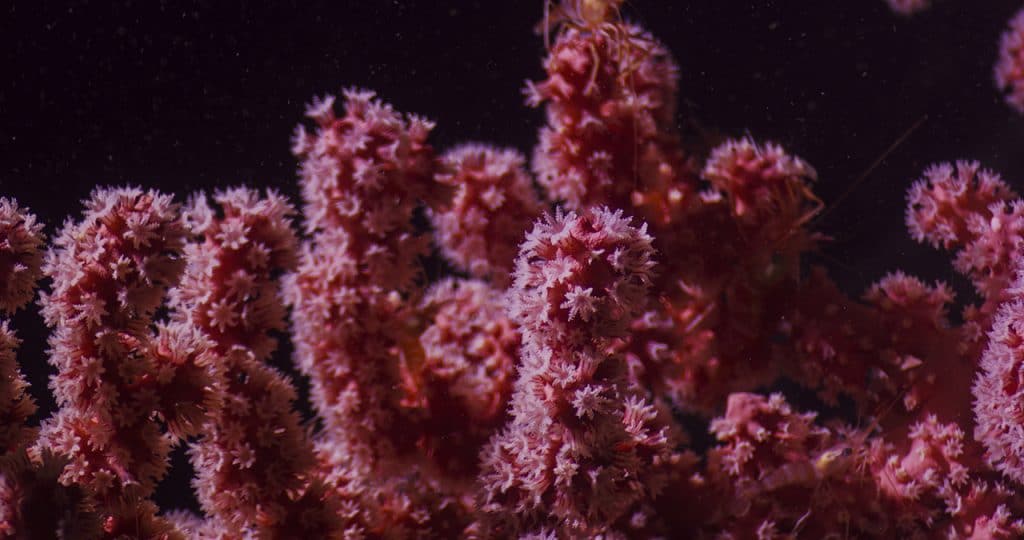New Deep-Sea Coral Species Discovered in Atlantic
Marine Monument
Woods Hole Oceanographic Institution
 |
| A bubblegum coral (Paragorgia spp.) similar to, but distinct from, the new species identified in Lydonia Canyon. (Photo by Ivan Agerton, OceanX) |
DNA
analysis recently confirmed that Woods Hole Oceanographic Institution (WHOI)
scientists and their collaborators at OceanX, the University of Connecticut
(UConn), and NASA’s Jet Propulsion Laboratory (JPL) discovered two new species
of deep-sea corals during a September 2018 expedition in the Northeast Canyons
and Seamounts National Monument, located about 100 miles from the Northeast
U.S. coast.
The
research team was led by deep-sea biologist Tim Shank of WHOI and
included co-PIs Taylor Heyl (WHOI), Rachel O’Neill (UConn), and John
Leichty (JPL). Utilizing OceanX’s research and exploration vessel Alucia, the
team explored and surveyed several of the unique deep-sea habitats in the
monument, which includes three underwater canyons deeper than the Grand Canyon.
During
the two-week expedition, the scientists collected a total of 29 coral samples
in Lydonia Canyon at depths between 369 meters (1,211 feet) and 903 meters
(2,963 feet) using the submarine Nadir. These were the first
human-occupied submersible dives in this canyon since 1982 and only the third
deep-submergence mission to Lydonia Canyon.
"Through
ongoing genetic barcoding, we have identified at least two corals so far that
represent genetically different species," Shank said. "They don’t
show sufficient genetic similarity to be any species that is currently known in
the world’s repository for DNA sequences."
According to Heyl, the two likely new species found in Lydonia Canyon are bubblegum corals, which she described as soft, deep-water corals, "with bundles of polyps that resemble wads of bubblegum along their branches."
"We
didn’t expect to find bubblegum corals there at all, since they haven’t been
found in any of the neighboring canyons," Shank said. "We found pink,
red, and white bubblegum corals thriving there."
"We
observed a high diversity of other corals—at least 24 species—on the seafloor
and are discovering more through genetic analyses," he added.
Shank
noted that coral species deep in the canyon at more than 900 meters (2,953
feet) below the surface were very different from those found in shallower
waters. In total, the team collected some 200 samples of corals, sponges, and
other marine life during the expedition’s three submersible dives.
"We’re still analyzing the data," he noted. "But we found surprising patterns of species diversity at different depths and among the different canyons in the monument."
Corals
found at these depths grow at an extremely slow pace: One that is a foot tall
could be as much as 500 years old. Deep-water corals around the world also
provide the framework to support entire ecosystems that contain more than 2,500
species living on and around them, including brittle stars, squat lobster
crabs, and sea lily crinoids.
In
addition, the team tested a new universal barcode for invertebrates during the
expedition. Barcoding is a technique that uses a specific segment of an
organism's DNA to identify different species at the genetic level, rather than
by analyzing an organisms physical characteristics.
UConn's O'Neill and her team were able to validate the effectiveness of the new barcode by distinguishing all of the different salp species present in a single, commingled sample. Salps are a gelatinous, free-swimming animal common to the open ocean that may play an important role in Earth's climate system by consuming carbon near the surface and excreting it in pellets that sink into the deep ocean.
UConn's O'Neill and her team were able to validate the effectiveness of the new barcode by distinguishing all of the different salp species present in a single, commingled sample. Salps are a gelatinous, free-swimming animal common to the open ocean that may play an important role in Earth's climate system by consuming carbon near the surface and excreting it in pellets that sink into the deep ocean.
The
monument was created by President Barack Obama in 2016 and is the first and
only national marine monument in the Atlantic Ocean. However, it is currently
under threat of losing its protected status.
“The
Northeast Canyons represent some of the most unique and biodiverse habitats in
the Atlantic Ocean, and exploring and understanding these canyons is critical
to creating awareness for and protecting them,” said Vincent Pieribone, Vice
Chairman, OceanX.
“We are thrilled to learn with our partners at WHOI, JPL, UConn and Bloomberg Philanthropies that this mission uncovered new species of coral. These discoveries will help move us toward a better understanding of our oceans, our planet’s most important and most under-examined natural resource.”
“We are thrilled to learn with our partners at WHOI, JPL, UConn and Bloomberg Philanthropies that this mission uncovered new species of coral. These discoveries will help move us toward a better understanding of our oceans, our planet’s most important and most under-examined natural resource.”
The
expedition was made possible through the Bloomberg-OceanX partnership and
pledge of a combined $185 million over the next four years to facilitate ocean
exploration and conservation around the world. Through the partnership,
Bloomberg Philanthropies and OceanX aim to create a critical platform to
increase the world’s collective understanding of and engagement in our oceans.
